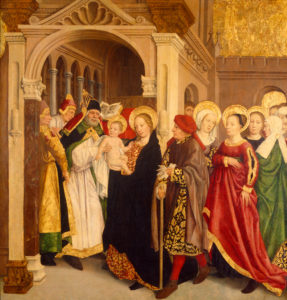Object of the Month: January 2021
The Presentation of Christ in the Temple
Tempera on canvas, monogrammed and dated 1490 (lower left on base of column)
Antoine de Lonhy, called the Master of the Trinity of Turin
French (active in Spain and Flanders), c. active 1460–1490
French-born Antoine de Lonhy painted this vibrant scene around 1490. Although he trained in the Burgundy region of France, de Lonhy spent parts of his early career in Toulouse and Barcelona. He worked his later years in what is today the Piedmont and Aosta Valley regions of Italy. For many years, de Lonhy’s identity remained a mystery, and he was known only as the Master of the Trinity of Turin. Only in the past 20 years have scholars been able to identify de Lonhy and associate his name with his varied body of work. De Lonhy was a true Renaissance man whose work included panel paintings, illuminated manuscripts, frescoes, and stained glass, as well as textile and sculpture designs.
The Presentation of Christ in the Temple was originally painted on panel and at some point, transferred to canvas. M&G’s painting is believed to have been part of a large, lost altarpiece of a church in Piedmont. Another of de Lonhy’s works, Mort de la Verge, displays the same raised gold-leaf technique as well as similar colors and patterns to M&G’s Presentation. It is possible that both panels were once part of the lost altarpiece. De Lonhy’s masterful skill shines in all the details of this work, especially in his pristine architectural elements. The raised gold-leaf, particularly on the halos and borders of the garments, provides texture and dimension. His use of vibrant colors and patterns beautifully illustrates the joyfulness of the occasion. Mary lovingly presents the Christ Child to the priest while Joseph looks on carrying their offering of two turtledoves. Ironically, de Lonhy clad Mary and Joseph in rich, brocade garments which contrasts with the turtledoves, the offering of the poor.
Luke 2:22-40 illuminates the narrative of this scene. Jewish law required a woman to be purified 40 days after giving birth to a son. The mother was required to bring an offering of a year-old lamb or two young pigeons or turtledoves (for those who could not afford a lamb). This offering was presented to the priest who sacrificed them before the Lord to make atonement for the mother (Leviticus 12:1-8). The law of Moses also required the consecration of every firstborn male. In accordance with the law, Mary and Joseph traveled to the temple in Jerusalem to present Christ for consecration. Luke tells of the priest, Simeon, who was promised “by the Holy Spirit that he would not die until he had seen the Lord’s Messiah.” De Lonhy captures the moment when that promise to Simeon was fulfilled: Mary presented the Lord’s Messiah to Simeon for consecration leading Simeon to respond with praise to and adoration of God. Simeon witnessed with his own eyes God’s fulfillment of His promise.
Rebekah Cobb, Registrar
Published in 2021

